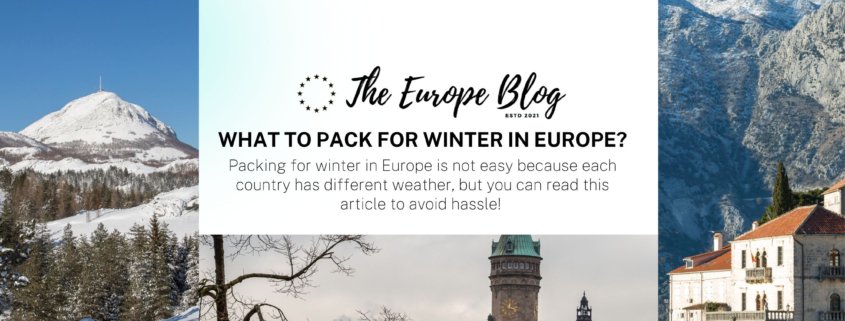What to pack for winter in Europe?
Packing for winter in Europe is not easy because each country has different weather, but you can read this article to avoid hassle!
What to pack for winter in Europe?
Although most countries in Western Europe have an oceanic climate, featuring cool winters and warm summers with cloudy skies, countries in the southern region have a Mediterranean climate, boasting dry and hot summers with sunny skies. So, what to pack for the winter season in Europe? Here are a few practical tips and tricks. Read on!
Packing for Winter in Europe
Winter in Europe is quite unpredictable, making the packing process more difficult. Before you start packing, you need to decide whether to cram everything into a backpack or take a large suitcase with you. Most people carry a backpack, but some prefer bags on wheels. Because both options have pros and cons, it is better to make an informed choice to avoid the hassle.
Suitcase or Bag
Many tourists in Europe find it daunting to walk to the metro or bus stop from the hotel. The reason is that sidewalks in many countries are for pedestrians with no taxi service. It means you can’t call for a taxi while walking on the sidewalk. When stuffing your bag, remember that you will have to carry it up and downstairs and crowded streets.
It is best to take a suitcase with two robust wheels. All-wheel drive is great for airports and smooth surfaces but unbearable on rougher terrain. The suitcase is the perfect travel companion for winter excursions.
Backpack
Travel backpacks are great because they make it easy to walk upstairs or in crowds and still have your hands free. On the other hand, a bunch of all sorts of stuff behind your back can make you angry in 3-4 hours.
Make sure you avoid taking a school-sized backpack because the airline may not allow it as hand luggage. Find the necessary information and follow the rules when choosing a backpack for a European trip.
Focus on Layers
Experienced tourists will always choose several different sweaters instead of one thick sweater. Remember, this is the main secret (if you did not know) because this method helps you stay warm without carrying sweaters that take up all the space in your bag.
The base layer is the bottom layer designed to absorb your sweat. The middle layer is regular clothing. For example, it includes a shirt, sweatshirt, long-sleeved clothes, sweatshirt, etc. The outer layer is a “protective barrier” from wind, rain, and snow. The ideal option is a membrane jacket for both men and women.
Above zero temperatures mean snowfalls and even rains. Therefore, we recommend getting a waterproof jacket and always with a hood. Choose the endurance of outerwear up to -5 degrees.
On the other hand, if you put on a warm sweater down, you will not freeze even during a long walk. A good choice is membrane jackets. Although these jackets appear thinner, they are more generous than other types of stuff.
Fleece sweaters and sweaters are suitable in Europe. In contrast, an all-wool sweater will be a bit hot in Europe. Thermal underwear will not be superfluous. So, make sure you purchase a quality product.
The fact is that in European cities in late autumn, winter, and early spring, heating systems barely works, and in some hotels, it may not be available at all. Therefore, make sure you shop for a quality one when buying thermal underwear.
Shoes
If you plan to walk all day, buy insulated shoes made from natural materials that will not get wet. If you are a woman, avoid wearing high heels or unstable soles. Genuine leather on the outside and natural wool on the inside will keep your feet warm during long walks or outings.
Another good option to keep your feet warm is to use special heated insoles. However, you also need warmer socks: if you use heated insoles, it is better not to wear woolen socks. Avoid cotton socks in winter because they won’t protect you from the cold.
Final Words
Winter in Europe varies from country to country. For example, if you are traveling to northern Europe, you will experience extreme cold. On the other hand, if you are traveling in southern Europe, you will experience fluctuations in weather from moderate to cold. That’s why it is essential to pack according to the weather conditions. Until Next Time!
- Article based on personal opinion, experience and research.
- Photos from Unsplash & canva.










